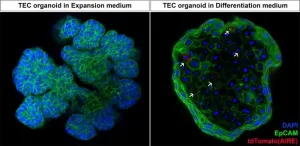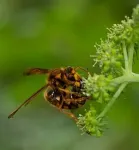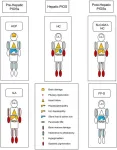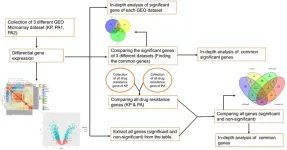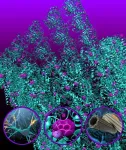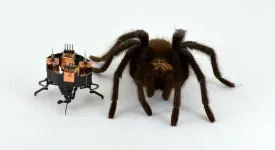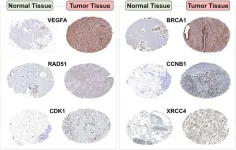(Press-News.org) Researchers from the Organoid group have developed a new organoid model that can be used to study the thymus. The organoids, derived from mouse thymus tissue, specifically model thymic epithelial cells (TECs). These cells are responsible for training the T cells of the immune system to properly respond to pathogens. It is the first laboratory model that enables long-term culture of TECs, which presents new opportunities to study their function. Ultimately, this could also bring new insights into the treatment of patients with impaired thymus function. The study was published in Cell Reports on 27 March 2024.
Our immune system protects us from pathogens like viruses and bacteria. In order to effectively detect and eliminate these, several types of white blood cells are required, including T cells. Before they can do their job, T cells need to be trained to only attack pathogens and not the body’s own cells. This happens in the thymus, a small organ located behind the breastbone. The ‘teachers’ in this training process are called TECs. They present all kinds of molecules to the T cells and eliminate those that do not respond properly. The end result is mature T cells that enter the bloodstream, ready to respond to pathogens.
Organoids to model the thymus
Researchers studying TECs need a way to grow these cells in the laboratory. The Organoid group has now succeeded in developing a new system: TEC organoids, based on thymus tissue from mice. First author on the study Sangho Lim explains the advantage of these organoids compared to previous systems: “Before, it was not possible to keep TECs alive in culture for long. This made it difficult to study them and to do experiments. Our TEC organoids can be kept in culture for over two years, so that allows for long-term experiments.”
Compared to other culture systems, the organoids are also a better representation of the diversity of TECs in the body. Specifically, two different subtypes of TECs exist, cortical and medullar TECs, depending on where in the thymus they are present. These subtypes also have specific functions in training T cells. “By adding a different cocktail of molecules to the organoids, we can direct the cells to specialize into the cortical and medullar subtypes. Before, it was difficult to get this diversity of TECs in culture,” Lim says.
Training T cells
Lim and his colleagues also confirmed that the TECs in the organoids were capable of doing their job: training T cells. “We first mixed the organoids together with immature T cells in culture. We then followed their maturation by looking at the molecules CD4 and CD8 on the outside of the cells. In the body, immature T cells acquire and lose these molecules in a specific order during their development. This corresponded nicely with what happened in our culture plates,” says Lim.
The researchers obtained similar results in mice born without a thymus. Lim: “These mice have very low numbers of mature T cells in the blood, because they have no thymus to train them. When we transplanted our TEC organoids under their skin, we saw a very clear increase of the amount of mature T cells in their blood.” It therefore seems that the TEC organoids were capable of taking over the function of the missing thymus by stimulating T cells to mature.
New possibilities
The mouse TEC organoids open up new possibilities for scientists studying the thymus and T cell maturation. From a clinical perspective, this is especially relevant for patients with impaired thymus function, a condition that can be due to specific cancer treatments or neonatal heart surgeries. “In the future, we might be able to explore transplantation of TEC organoids as a treatment strategy to restore thymus function. But a lot of work still needs to be done before we get there,” Lim concludes.
Publication
Derivation of functional thymic epithelial organoid lines from adult murine thymus. Sangho Lim, Gijs J. F. van Son, Ni Luh Wisma Eka Yanti, Amanda Andersson-Rolf, Sam Willemsen, Jeroen Korving, Hong-Gyun Lee, Harry Begthel, and Hans Clevers. Cell Reports, 2024.
*****************************************************************************************************************************************************************************************************************
About Hans Clevers
Hans Clevers is advisor/guest researcher at the Hubrecht Institute for Developmental Biology and Stem Cell Research (KNAW) and at the Princess Máxima Center for Pediatric Oncology. He holds a professorship in Molecular Genetics from the Utrecht University and is an Oncode Investigator. Hans Clevers has been the Head of Pharma Research and Early Development (pRED) at Roche since 2022. He previously held directorship/President positions at the Hubrecht Institute, the Royal Netherlands Academy of Arts and Sciences and the Princess Máxima Center for pediatric oncology.
About the Hubrecht Institute
The Hubrecht Institute is a research institute focused on developmental and stem cell biology. Because of the dynamic character of the research, the institute has a variable number of research groups, around 20, that do fundamental, multidisciplinary research on healthy and diseased cells, tissues and organisms. The Hubrecht Institute is a research institute of the Royal Netherlands Academy of Arts and Sciences (KNAW), situated on Utrecht Science Park. Since 2008, the institute is affiliated with the UMC Utrecht, advancing the translation of research to the clinic. The Hubrecht Institute has a partnership with the European Molecular Biology Laboratory (EMBL). For more information, visit www.hubrecht.eu.
END
Scientists develop new organoid model to study thymus function
2024-04-29
ELSE PRESS RELEASES FROM THIS DATE:
A revised classification of primary iron overload syndromes
2024-04-29
Background and Aims
The clinical introduction of hepcidin25 (Hep25) has led to a more detailed understanding of its relationship with ferroportin (FP) and divalent metal transporter1 in primary iron overload syndromes (PIOSs). In 2012, we proposed a classification of PIOSs based on the Hep25/FP system, which consists of prehepatic aceruloplasminemia, hepatic hemochromatosis (HC), and posthepatic FP disease (FP-D). However, in consideration of accumulated evidence on PIOSs, we aimed to renew the classification.
Methods
We ...
Expanding health equity by including nursing home residents in clinical trials
2024-04-29
INDIANAPOLIS – Clinical trials are constantly being designed and study participants enrolled to determine if medical treatments and therapies are safe and effective. Much has been written about the importance of including diverse populations in these trials.
However, the nearly 1.4 million individuals who live in the 15,600 nursing homes across the U.S. have been largely left out of clinical trials, despite the prevalence of such common conditions as hypertension, depression, diabetes and Alzheimer’s disease in this population.
A commentary by faculty of Regenstrief Institute, Indiana University, UCLA ...
Identification and exploration of transcripts involved in antibiotic resistance mechanism of two critical superbugs
2024-04-29
Background and objectives
Infectious diseases caused by pathogenic strains of bacteria are a global cause of morbidity and mortality. Hospital-acquired infections caused by Klebsiella pneumonia and Pseudomonas aeruginosa were found vulnerable during the COVID-19 pandemic. They are also responsible for the onset of certain life-threatening infectious diseases such as cystic fibrosis, endocarditis, bacteremia, and sepsis. Looking into the importance of these two superbugs there is a strong need for extensive comparative differential gene expression analysis ...
Quantum fiber optics in the brain enhance processing, may protect against degenerative diseases
2024-04-29
WASHINGTON, DC – (April 26, 2024) The effects of quantum mechanics—the laws of physics that apply at exceedingly small scales—are extremely sensitive to disturbances. This is why quantum computers must be held at temperatures colder than outer space, and only very, very small objects, such as atoms and molecules, generally display quantum properties. By quantum standards, biological systems are quite hostile environments: they’re warm and chaotic, and even their fundamental components—such as cells—are considered very large.
But ...
Icahn School of Medicine at Mount Sinai names Miriam Merad, MD, PhD, as Dean for Translational Research and Therapeutic Innovation
2024-04-29
New York, NY [April 29, 2024]—Miriam Merad, MD, PhD, a world-renowned immunologist, has been appointed Dean for Translational Research and Therapeutic Innovation of the Icahn School of Medicine at Mount Sinai. The appointment reaffirms Icahn Mount Sinai’s commitment to pioneering medical progress and catalyzing the rapid advancement of research innovation.
Dr. Merad, the Mount Sinai Professor in Cancer Immunology, will also continue to serve as the founding Chair of the Department of Immunology and Immunotherapy, Director of the Marc and Jennifer Lipschultz Precision Immunology Institute, and Director ...
Details of hurricane Ian’s aftermath captured with new remote sensing method
2024-04-29
Category 4 Hurricane Ian made landfall in Florida’s Lee County on Sept. 28, 2022, battering the region with wind speeds of 155 miles per hour and storm surge up to 13 feet – the highest storm surge documented in Southwest Florida in the past 150 years.
In the aftermath of a disaster, rapidly assessing damage is critical for rescue, recovery and emergency planning. Damage assessments are typically conducted through field reconnaissance deployments, which can be labor-intensive, costly and risky. Moreover, field-based emergency response ...
Robots can’t outrun animals. A new study explores why
2024-04-29
The question may be the 21st century’s version of the fable of the tortoise and the hare: Who would win in a foot race between a robot and an animal?
In a new perspective article, a team of engineers from the United States and Canada, including University of Colorado Boulder roboticist Kaushik Jayaram, set out to answer that riddle. The group analyzed data from dozens of studies and came to a resounding “no.” In almost all cases, biological organisms, such as cheetahs, cockroaches and even humans, seem to be able to outrun their robot counterparts.
The researchers, led by Samuel Burden at the University of Washington and ...
The Human Immunome Project unveils scientific plan to decode and model the immune system
2024-04-29
NEW YORK, April 29, 2024 – The Human Immunome Project (HIP), a global nonprofit scientific initiative, released its Scientific Plan today, on World Immunology Day, the organization announced. The plan provides a detailed roadmap of how the Human Immunome Project and its network of global study sites will generate the world’s largest and most diverse immunological dataset and use these data to power publicly available AI models of the immune system.
“The immune system is the epicenter of human health, and our newly released ...
New research funding awarded to assess the role of race in predicting heart disease
2024-04-29
Highlights:
The American Heart Association awarded four new scientific research grants to evaluate the role of race in measuring heart disease risk.
The funded studies are focused on multi-ethnic groups and studying how race, considered a social rather than biological construct, affects health risk prediction when it is incorporated as a variable in algorithms.
This research is funded by a grant from the Doris Duke Foundation to study the complex issue of how race and ethnicity, when factored into cardiovascular clinical care algorithms ...
Exploring the role of seven key genes in breast cancer: insights from in silico and in vitro analyses
2024-04-29
Background and objectives
Breast cancer remains a significant global health concern, warranting further exploration into its genetic basis and potential therapeutic targets. This study aimed to elucidate the genetic associations of seven pivotal genes with breast cancer and discern their potential role in disease prognosis.
Methods
The genes VEGFA, BRCA1, RAD51, CCNB1, CHEK1, CDK1, and XRCC4 were curated from over 30 articles. Their association with breast cancer was analyzed using both in silico and in vitro techniques. The in silico assessment ...
